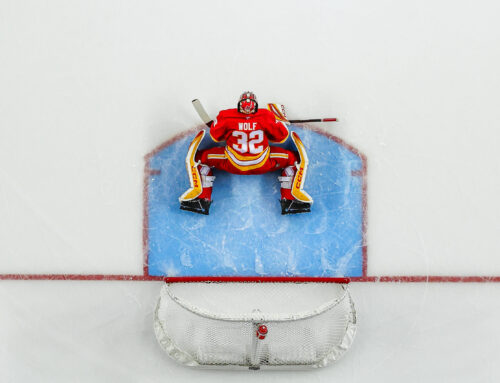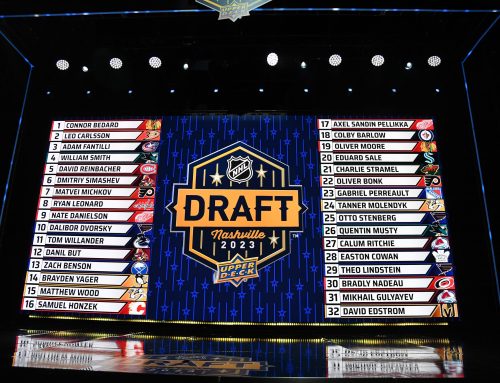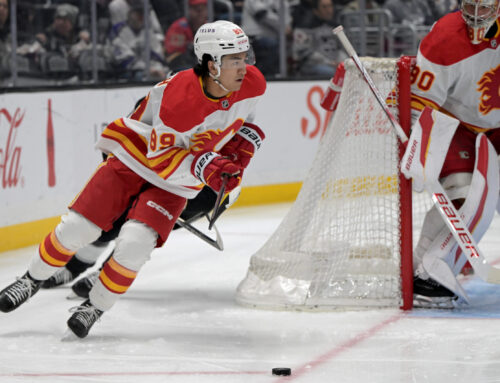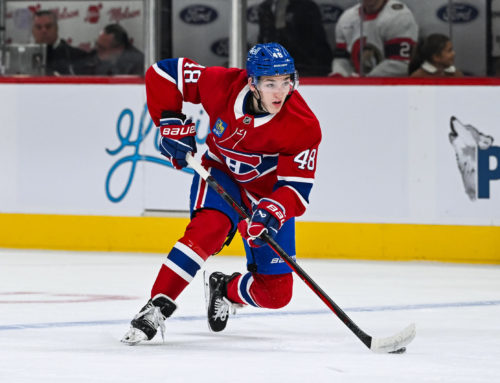
Happy Belated New Year’s, Journeyers! I didn’t get many responses regarding anyone’s resolutions from last week so I’ll just go ahead and assume that we’re all resolving to read more Dobber articles and continue to make progress in our leagues as we push into 2019 – if you hadn’t already decided that… you’re welcome!
Today we’re having a look at the rookie scoring race, but from a different angle than we’re used to seeing on the major networks. I decided to break the short list into three top-tiers, based on a rough history of how rookies with these rates typically pan out. Kicking things off, though, we don’t have much of a surprise. The criteria for this list was a minimum of 15 games played this season.
Tier I: EP (3.00 points/60+)
The numbers don’t lie, Elias Pettersson is a gimme in just about every category. If you don’t know that by now, you’ve likely just recently emerged from your home under a rock. His scoring clip (3.73 points/60) as we near the halfway point of the season is comparable to the league’s most elite players… not as rookies but today. Although he hasn’t flinched the one inflated statistic that would indicate a dip in his current pace is his 28% shot success rate. The rate exceeds other elite-level snipers averages such as Patrik Laine, Steven Stamkos, and Alex Ovechkin by double digits.
By adjusting his shooting rate to a more realistic expectation (but still on par with other top snipers), we’d likely see his season-long goal scoring totals in and around the 35-goal mark, given his shooting frequency as opposed to his current 48-goal pace. At that expected total, his points/60 would drop to a rate of 3.10 points/60 – still exceptional, and an expected point per game rate of 1. Essentially, we’re expecting that EP will regress to a scoring rate of a truly exceptional NHL player with several years remaining to reach his full real-world potential. Based on these numbers, I expect him to be a top-twenty contributor in points-only leagues for the next 10+ years.
Like I said though, chances are you already knew most of this, and unless he’s available in some kind of an upcoming draft. Right now, you either have him, or you don’t – I’m with the latter, and I have to say, my friends, nobody should be giving this kid up any time soon.
Bottom line: The highest full seasons for points/60 rate since 2009-10 by a rookie was 3.50 by Mathew Barzal, followed by Connor McDavid at 3.39.
Tier II: Take note – this rate doesn’t usually happen by accident (2.50-2.99 pts/60)
This 25-year old rookie just barely meets the games played threshold for this investigation. That being said, he does in-fact meet them, and he’s currently leading the second tier scoring rate at a pace of 2.94 points/60. While his shooting percentage is on the higher side, it’s not quite inflated to the point that Pettersson’s is. For every five shots, Boyd has been finding the net once through the course of his first 20 games this year.
Some of the most positive indicators included in Boyd’s statistic line include the fact that of his eleven points this year, ten have come at even strength, and seven have come as assists which helps to overlook his barely inflated shooting rate. Of his seven assists, five have come in the form of primary assists alongside the likes of Nic Dowd, Devante Smith-Pelly, and Andre Burakovsky – hardly elite finishers.
With these indicators trending on their current path, Boyd appears to be proving himself as a late-blooming depth playmaker. While his age and lack of NHL experience should be taken into consideration, there appears to be potential for him to remain in the league long-term as a productive depth player – think Mathieu Perreault in terms of upside.
Bottom Line: Jeremy Morin scored at a very similar rate over the same period in his rookie campaign… His NHL career ended in 2015 with a career total of 22 points. The sample size here is a concern.
Minus a rough patch through the first two weeks of December, the youngest Tkachuk has been every bit as impressive as his elder brother was in his rookie campaign, and probably more. His 2.56 points/60 minutes have come evenly in the form of assists as well as goals while being flanked almost exclusively by Mark Stone. The two seem to have developed an excellent chemistry in the first half of the year which provides an interesting indicator to keep in mind with Tkachuk’s future. With Stone’s pending unrestricted free agency, Tkachuk could be looking at the loss of a critical linemate if the Sens decide not to pony up.
Despite the frightening statistics that would indicate some dependence on Stone, it’s important to realize that the two have been joined at the hip since Tkachuk’s NHL debut. A measly 6.6% of Tkachuk’s total even-strength deployment has been without Stone. In the case that Tkachuk is left to his own devices in the future, his intense drive and work ethic are likely to be compatible with other offensive weapons in the Senators’ shallow artillery.
Matthew Tkachuk’s rookie campaign saw him wrap up a 70-game rally with a 2.58 points/60 minutes – a mere 0.02 lead on Brady’s current pace. Although his then linemakes weren’t exactly Mark Stone-level (Michael Frolik & Mikael Backlund) the two brothers certainly seem like copies of one another, and that makes the future look quite bright for the Senator forward.
Bottom Line: David Pastrnak scored at a comparable rate in his rookie campaign. His contributions also came mostly in the form of assists alongside Milan Lucic, who, if you remember, wasn't always a massive liability.
Tier III: They’re good, but good help will take them to another level” (2.25-2.49 pts/60)
Sample size isn’t an issue when it comes to the second Senator’s forward to find his way on to this list. Although he’d already played a handful of games in the league prior to this year, the NHL considers him a rookie once again. White falls under a similar category to Brady Tkachuk, however, in the sense that the majority of his ice time has come alongside Mark Stone. The silver lining to this apparent dependence is that the two rookies will be Senator property for several more years, so long as the team desires it to be so. While they both seem to have developed a stunning chemistry with Stone, that chemistry also appears to be trilateral, connecting the two of them to one another.
The trouble, if Stone does in fact find his way out of Ottawa in the coming year, is that the two will indeed be short a sniper. White’s point scoring rate of 2.36 points/60 minutes has a similar makeup to Tkachuk whereby his assists account for the majority of his production.
Foreshadowing and assumptions aside, White appears to have made his entry to the NHL at a very appropriate time for his development.
Bottom Line: Max Domi and Nico Hischier performed strangely similar in their rookie campaigns. While neither have necessarily had the time or opportunity to truly expand their development to a consistent level, they give some indication as to what we should expect from White as an NHL player.
The Leafs rookie has moved up in the lineup as of late, and his production has benefited enormously. Skilled linemates such as Mitchell Marner have certainly had an effect on the seventh-round draft-pick’s confidence at the NHL level, where he’s now proving himself to be capable of a top-6 position. His scoring rate of 2.28 points/60 minutes is at the baseline of what typically results in a positive NHL career, which makes for an appropriate cut-off point for this list.
Despite his recent success alongside the Leafs’ more namely players, Johnsson had less trouble contributing with his fourth-line buddies than you might actually think. His five points while flanking Par Lindholm with Connor Brown have accounted for about 35% of his even strength production, almost identical to his even strength deployment rate with that group.
Bottom Line: If the Leafs are able to keep Johnsson in the fold with some of their skilled core, it looks like he will be an excellent complementary piece for years to come. A Carl Hagelin-like trajectory would be a safe comparison
As always, thanks for reading! Feel free to get involved in the discussion below or on Twitter with me @olaf1393.





 EDM
EDM FLA
FLA MIN
MIN L.A
L.A TOR
TOR DAL
DAL NYI
NYI S.J
S.J COL
COL CHI
CHI CAR
CAR
